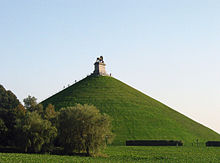
Back Löwenhügel (Waterloo) German Colina del León Spanish Butte du Lion French Lavlji brežuljak Croatian Oroszlános-domb Hungarian Singa Waterloo ID Collina del leone Italian Leeuw van Waterloo Dutch Løvehaugen NB Kopiec Lwa Polish
 The immense Butte du Lion ("Lion's Mound") overlooking the battlefield of Waterloo | |
 | |
| 50°40′42″N 4°24′17″E / 50.67833°N 4.40472°E | |
| Location | Braine-l'Alleud, Walloon Brabant, Belgium |
|---|---|
| Designer | Charles Vander Straeten, Jean-Louis Van Geel |
| Beginning date | 1820 |
| Completion date | 1826 |
| Dedicated to | Battle of Waterloo |
The Lion's Mound (French: Butte du Lion, lit. "Lion's Hillock/Knoll"; Dutch: Leeuw van Waterloo, lit. "Lion of Waterloo") is a large conical artificial hill in the municipality of Braine-l'Alleud, Walloon Brabant, Belgium. King William I of the Netherlands ordered its construction in 1820, and it was completed in 1826. It commemorates the spot on the battlefield of Waterloo where the king's elder son, Prince William of Orange, is presumed to have been wounded on 18 June 1815, as well as the Battle of Quatre Bras, which had been fought two days earlier.
The hill offers a vista of the battlefield, and is the anchor point of the associated museums and taverns in the surrounding Lion's Hamlet (French: Hameau du Lion; Dutch: Gehucht met de Leeuw).[1] Visitors who pay a fee may climb up the mound's 226 steps,[2] which lead to the statue and its surrounding overlook (where there are maps documenting the battle, along with observation telescopes); the same fee also grants admission to see the painting Waterloo Panorama.[3]
- ^ À la découverte des lieux de Waterloo Archived 2015-01-10 at the Wayback Machine; Kennismaking met de omgeving Archived 2015-03-30 at the Wayback Machine
- ^ "Memorial Waterloo 1815". Retrieved 5 August 2019.
- ^ As of 2015[update], €16 for an adult. See Waterloo Battlefield site: Rates (French notice Archived 2015-01-16 at the Wayback Machine).